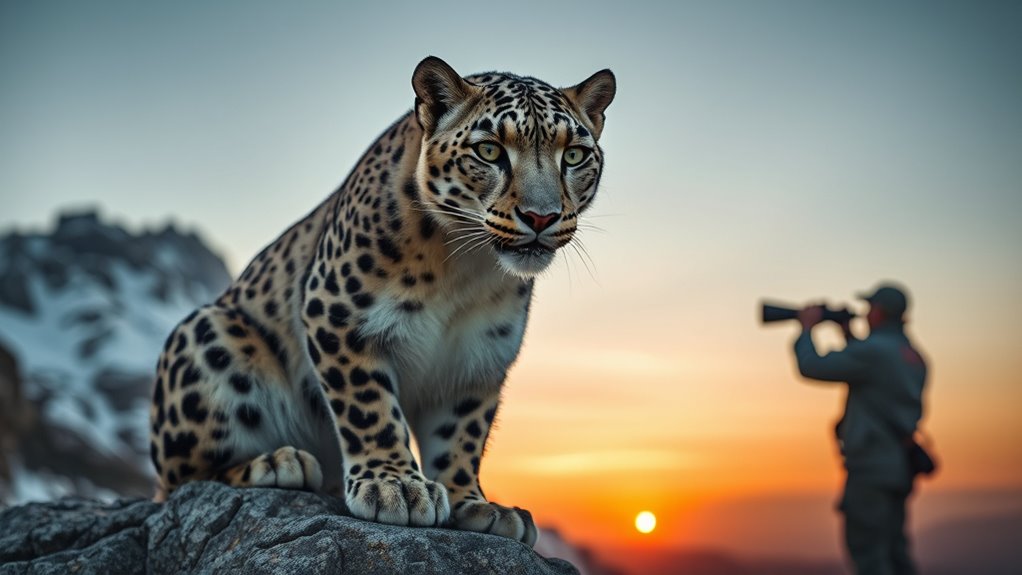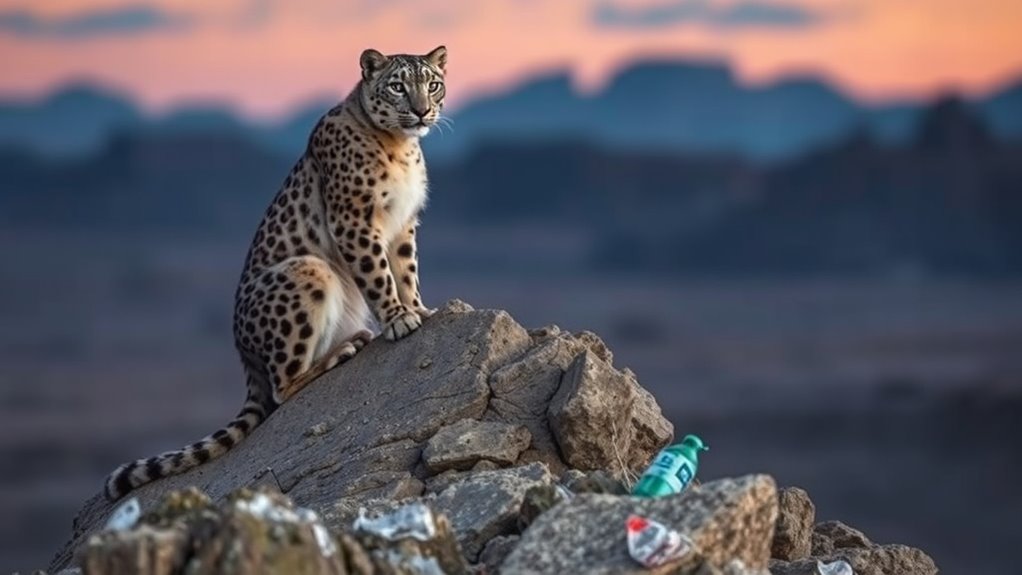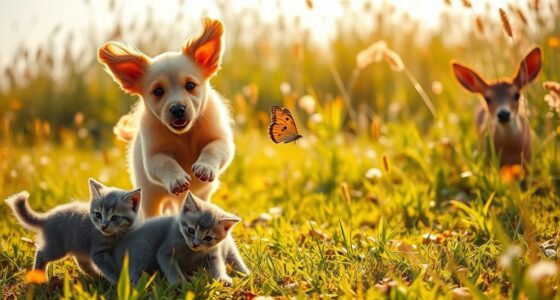Many animals are endangered due to significant threats like habitat loss, climate change, and human activities. Urban expansion and deforestation fragment habitats, making survival tough for many species. Overhunting and invasive species further exacerbate their plight. Climate change alters ecosystems, affecting food sources and breeding grounds. Without genetic diversity, populations struggle to adapt. To understand more about what's driving extinction and how you can help, keep exploring the important aspects of conservation and our role in it.
Key Takeaways
- Habitat loss due to human activities like deforestation and urban expansion significantly threatens animal populations.
- Overhunting and overfishing lead to drastic declines in numerous species, pushing them toward endangerment.
- Invasive species disrupt ecosystems, harming native animal populations and reducing biodiversity.
- Climate change alters habitats and food availability, making survival increasingly difficult for many species.
- Pollution, particularly from plastics, negatively impacts wildlife health and contributes to population declines.
Definition of Endangered Species

When you think about endangered species, picture organisms on the brink of extinction. An endangered species is any organism facing a significant risk of extinction due to critically low populations.
To be labeled as endangered, a species may experience a population reduction of 50-70%, occupy an area of less than 5,000 square kilometers, or have fewer than 2,500 mature individuals. Habitat loss, climate change, and human activities often drive these declines.
A species is deemed endangered if it faces significant population decline, limited habitat, or critically low mature individuals.
As of now, over 26,500 species are considered in danger of extinction, with more than 1,600 threatened or endangered in the United States alone.
The International Union for Conservation of Nature (IUCN) maintains the Red List of Threatened species, categorizing organisms as vulnerable, endangered, or critically endangered, highlighting urgent conservation efforts.
Historical Context of Extinction

Throughout Earth's history, extinction has shaped the planet's biodiversity, and understanding its historical context reveals how environmental changes have influenced species survival.
We've faced five mass extinctions, often triggered by dramatic events like asteroid impacts or volcanic eruptions. Gradual shifts, such as mountain formation, also challenge species' adaptability, leading to extinction.
Today, extinction rates have skyrocketed, with estimates showing that 100 to 10,000 species vanish each year, far exceeding historic norms. This crisis stems largely from human activity, including habitat destruction and pollution, which exacerbate climate change and result in significant loss of habitat.
Consequently, many species find themselves in endangered status, struggling to survive in a rapidly changing world.
Major Causes of Endangerment

The ongoing crisis of extinction today is largely driven by several major causes of endangerment that threaten wildlife worldwide.
Habitat loss, primarily from human activities like deforestation and urban expansion, considerably impacts species survival.
Overhunting and overfishing have led to drastic population declines, leaving species like the Passenger Pigeon extinct and Atlantic cod struggling to recover.
Invasive species disrupt local ecosystems, as seen with the brown tree snake in Guam, which decimated native bird populations.
Pollution, particularly plastic contamination, harms wildlife health, with all studied sea turtles showing plastic in their systems.
Finally, climate change exacerbates these issues, forcing species like polar bears to face vital survival challenges as their habitats are altered or diminished.
Conservation efforts are essential to counter these threats.
The Role of Habitat Loss

Habitat loss directly impacts wildlife, and you can see this through human development like housing and agriculture.
Climate change adds another layer of stress, altering environments that species depend on for survival.
Plus, invasive species often thrive in these disrupted habitats, further threatening the native wildlife you care about.
Human Development Impact
As human development continues to expand, it directly threatens countless animal species by destroying their habitats. Activities like housing, agriculture, and infrastructure lead to significant habitat loss. The Amazon rainforest has lost around 20% of its area in 50 years, primarily due to cattle ranching. Urban expansion fragments habitats, isolating native species such as the San Joaquin kit fox. This increases their vulnerability to extinction. Deforestation in places like the Amazon puts specialized species, including jaguars and sloths, at risk.
| Type of Development | Impact on Species | Example Species |
|---|---|---|
| Housing | Habitat fragmentation | San Joaquin kit fox |
| Agriculture | Deforestation | Jaguars, sloths |
| Urban expansion | Isolation | Various native species |
| Land use change | Endangerment | Orangutans |
Climate Change Effects
While human activities contribute greatly to habitat loss, climate change amplifies these threats by altering ecosystems and disrupting the delicate balance that many species depend on. As temperatures rise, you'll notice that certain species struggle to adapt, leading to increased habitat loss. For example, polar bears are losing their icy homes, while golden toads have already faced extinction.
- Extreme weather events devastate environments, making survival tough.
- Ocean acidification harms marine species and coral reefs, essential for aquatic life.
- Changes in precipitation and prolonged droughts degrade habitats, threatening amphibians.
As climate change continues to reshape our environment, more species become endangered, pushing them closer to extinction. It's a cycle that needs urgent attention.
Invasive Species Threats
Invasive species pose a significant threat to native wildlife, especially in areas where habitat loss has already weakened ecosystems. They often outcompete native species for resources, leading to drastic declines in populations and risking extinction.
For instance, the brown tree snake in Guam has decimated native bird species through predation, disrupting the ecosystem balance. Similarly, invasive plants like kudzu can choke out essential native vegetation, furthering habitat loss for those species dependent on it.
The European rabbit's rapid proliferation in Australia illustrates how invasive species can damage native flora, exacerbating habitat loss. These critical threats highlight how invasive species thrive in disturbed environments, underscoring the importance of addressing habitat loss to protect native wildlife.
Impact of Climate Change

Climate change is reshaping habitats and making it harder for species to adapt. As temperatures rise and weather patterns shift, animals like polar bears struggle to find the sea ice they need for survival.
You mightn't realize how these changes ripple through ecosystems, threatening the delicate balance that keeps many species alive.
Habitat Alteration Effects
As the planet warms and weather patterns shift, the effects of habitat alteration due to climate change become increasingly evident. You mightn't realize how this impacts endangered species and ecosystems around you.
- Habitat loss disrupts essential nesting sites for sea turtles in coastal habitats.
- Polar bears struggle as melting sea ice limits their hunting and breeding grounds.
- The golden toad's extinction is linked to changing temperatures and precipitation.
These alterations not only threaten wildlife but also lead to increased natural disasters like hurricanes and wildfires, wreaking havoc on the delicate balance of ecosystems.
It's vital to understand that our actions directly influence these changes, putting countless species on the brink of extinction.
Species Adaptation Challenges
When ecosystems shift due to changing temperatures, many species face significant adaptation challenges. Climate change leads to habitat loss, making it difficult for vulnerable species to adapt.
Take polar bears, for instance; they rely on sea ice for hunting and breeding, and its decline threatens their survival. Rising temperatures disrupt migration patterns for birds and marine life, affecting breeding success.
Additionally, ocean acidification harms coral reefs, putting marine biodiversity at risk. Specialized species like red pandas and koalas struggle with changing food availability, increasing their vulnerability to extinction.
These environmental changes exacerbate existing threats, such as disease and habitat loss, making it even harder for species with low genetic diversity to survive.
Genetic Variation and Its Importance

Genetic variation plays an essential role in a species' survival, especially as environmental conditions shift. It allows animals to adapt to challenges like diseases and climate change.
Without this diversity, populations struggle, leading to lower survival rates. Here are a few key points:
- Inbreeding reduces genetic diversity, making species more vulnerable.
- The cheetah exemplifies the dangers of low genetic variation due to historical inbreeding.
- Conservation genetics focuses on enhancing genetic diversity in endangered species.
Consequences of Extinction

The extinction of a species doesn't just affect that one organism; it can trigger a domino effect throughout entire ecosystems. When a species becomes extinct, the loss disrupts food chains, leading to further extinctions. For instance, the decline of pollinators like honeybees threatens crucial plant species, jeopardizing agriculture and food security. Apex species loss can cause changes in their environment, increasing wildfire and pandemic risks. The consequences are not just ecological; they can also have economic implications, potentially costing up to 18% of global output by 2050.
| Consequence | Example | Impact |
|---|---|---|
| Loss of Biodiversity | Extinct species | Disruption of ecosystems |
| Habitat Changes | Pollinator decline | Threat to food crops and plant species |
| Economic Loss | Declining industries | Impact on agriculture and pharmaceuticals |
Protect endangered species to mitigate these effects.
Conservation Efforts and Strategies

Extinction's ripple effects highlight the urgent need for effective conservation efforts.
To protect endangered species, it's essential to implement conservation strategies that focus on collaboration and innovation. You can help by supporting initiatives like the Endangered Species Act, which safeguards habitats and limits harmful activities.
- Local scientists are imperative for monitoring endangered species and understanding their unique needs.
- Engaging communities fosters a sense of responsibility, ensuring everyone plays a part in preservation.
- Fieldwork helps gather essential data, guiding targeted interventions for species recovery and maintaining habitat for other species.
How Individuals Can Contribute to Conservation

While many might think conservation is solely the responsibility of large organizations, individuals play a crucial role in preserving endangered species and their habitats.
You can support conservation efforts by choosing sustainably sourced products and avoiding items made from endangered species, which helps reduce demand for harmful practices.
Participating in community activities like clean-ups and habitat restoration directly protects wildlife.
By reducing plastic use and opting for eco-friendly alternatives, you greatly decrease pollution, a major threat to many endangered species.
Advocate for policies that safeguard these animals, such as the Endangered Species Act.
Finally, raise awareness about biodiversity and the plight of endangered species through social media and community education initiatives, inspiring others to join in the conservation journey.
Frequently Asked Questions
What Are the Reasons for Endangered Animals?
You might wonder why certain animals are endangered today. Habitat loss due to human activities like deforestation and urban development plays a huge role.
Overhunting and poaching threaten species like elephants and rhinos, while invasive species disrupt local ecosystems. Climate change alters habitats, making survival difficult for many.
Finally, pollution harms wildlife, especially in aquatic environments. Together, these factors create a challenging situation for animals trying to survive in their natural habitats.
What Is the #1 Most Endangered Animal?
The #1 most endangered animal is the Vaquita, a tiny porpoise found in the Gulf of California.
With fewer than 30 individuals left, its survival hangs by a thread.
You might be shocked to learn that illegal fishing practices, especially the use of gillnets, are the main threat to this species.
Conservation efforts are underway, but without your support and awareness, the Vaquita could face extinction soon, highlighting the urgent need for action.
Why Are Some Animals Called Endangered Species?
Some animals are called endangered species because their populations are critically low, putting them at risk of extinction.
You'll find that factors like habitat loss, overhunting, and pollution contribute to this decline.
Conservation organizations use specific criteria, such as a significant population reduction or limited geographic range, to classify these species.
Understanding these factors helps you appreciate the urgency in protecting endangered animals and their habitats for future generations.
What Makes an Endangered Species?
Imagine a delicate dance on the brink of extinction. An endangered species is marked by its dwindling numbers, often facing a perilous path due to habitat loss, overhunting, or climate change.
When its population shrinks dramatically—by 50-70% over three generations, or occupies a tiny geographic area—it enters the endangered category.
You can spot these species on the IUCN's Red List, a vital tool for prioritizing conservation efforts and safeguarding our planet's biodiversity.
Conclusion
In summary, protecting endangered species is vital for maintaining our planet's biodiversity. Imagine a world without the majestic African elephant, whose decline not only impacts its ecosystem but also the cultures that revere it. By supporting conservation efforts and making conscious choices, you can help guarantee these incredible animals have a future. Every small action counts, and together, we can make a difference, preserving the beauty of our wildlife for generations to come.










